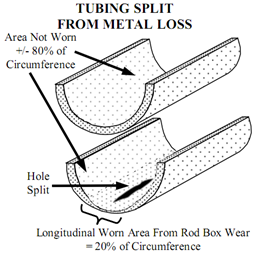The tubing, in a well produces by the mean of a rod pumping system, represents the second largest investment in the well. Every day, every stroke on the pumping unit can cause wear in the tubing. On ever stroke the rods move up and down. Especially for deviated wells, the rods will always tend to lie on the downside of the tubing. So, on every stroke of the pumping unit, the rods are wearing a path into the metal of the tubing, path that will become a hole in the tubing.

Rod-wear track in tubing (from a 1” Spray-Metal coupling rubbing in 2 7/8” tubing)
Tubing Wear:
In a typical pumping well running at 10 strokes per minute, the rods will move against the tubing 14400 times every day. This wear will eventually cause a tubing failure. A common tubing failure is termed a “tubing split” and normally will be thin on one side of the tubing’s internal surface (about 20% of the tubing’s circumference) and can be detected by pinging with a hammer, cutting open the tubing, or running a thumb inside the tubing to feel for the thin area. The outside of the tubing will normally have a “tubing split” where a thin crack 1 to 5 inches long runs along the longitudinal axis of the tubing as shown in the following figure.

In addition, other areas of the tubing may be thin and will leak when the tubing is pressure tested.
Tubing Rotator:
There is a system that will give the full use of the tubing, the “tubing rotator”. Tubing rotator spreads the wear from normally 20% of the circumference to 100% of the tubing’s circumference (to theoretically extend the tubing’s life by a factor of 5).
After the installation, the tubing rotator can be operated through one of the three methods:
- Manually driven: the operator rotates the tubing preferably on daily basis. Simply crank on the hand to rotate the tubing.
- Mechanically driven: by connecting the walking beam of the rod pumping surface unit to tubing rotator via a cable as shown in the following video.
- Electric motor driven.
All these options are generally provided with a shear mechanism to prevent over-torquing of the tubing string.
Case History:
Manual Tubing Rotation Reduces Rod Pumping Failures by 76%
Authors: Philip E. Hart (Omega Technologies Inc.)
Publication Date: 2003





